You're using an outdated browser. Please upgrade to a modern browser for the best experience.
Please note this is a comparison between Version 2 by Conner Chen and Version 1 by Hassan Ragab El-Ramady.
There is no human nutrition without crop production, which itself must be supported by proper and sufficient plant nutrients. These plant nutrients can play a crucial role in sustainably promoting agricultural production on cultivated lands, facilitating soil carbon sequestration, and taking pressure off global peatlands and forests
- plant
- Sustainable Agriculture
- climate change
- salinity
- drought
- biofortified crop
- nutrients
- degraded soil
- plant secondary metabolites
- elevated CO2
1. Introduction
The agroecosystem includes soil, cultivated plants, and other compartments [1]. This system has basic ecological and nutritional functions for human health, including fluxes of nutrients and energy and their interactions among different species, which control global food production [1]. The world’s population is expected to exceed 10 billion by 2050, and the world’s food production needs to increase more and more [2]. This food production is primarily dependent on crop productivity, and it is primarily controlled by the molecular–physiological functions of plant mineral nutrients and their deficiency [3]. Plant-derived nutrients are crucial for human nutrition and maintenance of human health [4]. There is no human nutrition without crop production, which itself must be supported by proper and sufficient plant nutrients [5]. These plant nutrients can play a crucial role in sustainably promoting agricultural production on cultivated lands, facilitating soil carbon sequestration, and taking pressure off global peatlands and forests [6]. Recently, several studies have reported on plant nutrition and its impact on human health, with topics such as the role of plants in human health with a focus on greening biotechnology [7], responsible plant nutrition [8], and the relationship between plant nutrition and food security under climate change [9]. It is also worth mentioning recent studies on the potential of aromatic, rare, and endemic wild species found in extensively controlled agroecosystems that have never used by humans [10][11], including crop wild relatives [12].
32. Plant Nutrition and Sustainable Agriculture
Plant nutrition deals with nutrient uptake, intravascular motility, nutrients’ roles in plant growth and development, and the physiological and biochemical functions of nutrients in plants. This science also includes the main methods for applying fertilizers or nutrients, the relationship between plant nutrition and human health as expressed in phytomedicine, and management of different cases of plant nutrients, particularly under environmental stresses in in vivo (Figure 21A,B) or in vitro studies (Figure 32). There are many methods that can be used to carry out studies on plant nutrition, including in vivo (in the field, greenhouses, pots, etc.) and in vitro (in the lab) methods, and they may use soilless culture, hydroponics, or micro-farm systems. These methods have different classifications, such as controlled and noncontrolled experiments [13][14], in vitro and in vivo studies, and quotative and qualitative studies [15].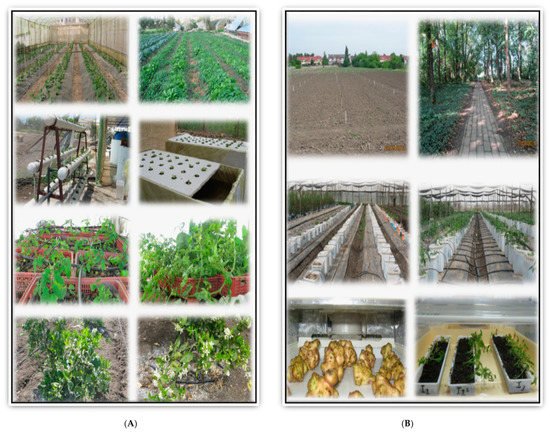
Figure 21. (A) Some photos of in vivo studies for plant nutrition investigations. The upper photos are from open field and greenhouse (the upper photos of cucumber and lettuce) and different hydroponic systems (the 4 middle photos of lettuce and tomato), whereas the lower photos (citrus plants) represent the soil application of mineral (super phosphate) and organic fertilizers (organic manure). These agricultural systems are found in the experimental farm at Kafrelsheikh University. (B) More studies on plant nutrition could be investigated within open field (the upper photo left), forest (the upper photo right), and greenhouse using different growing systems (the middle photos), whereas the lower photos represent the micro-farm system using growing media or without growing media. All photos by El-Ramady.
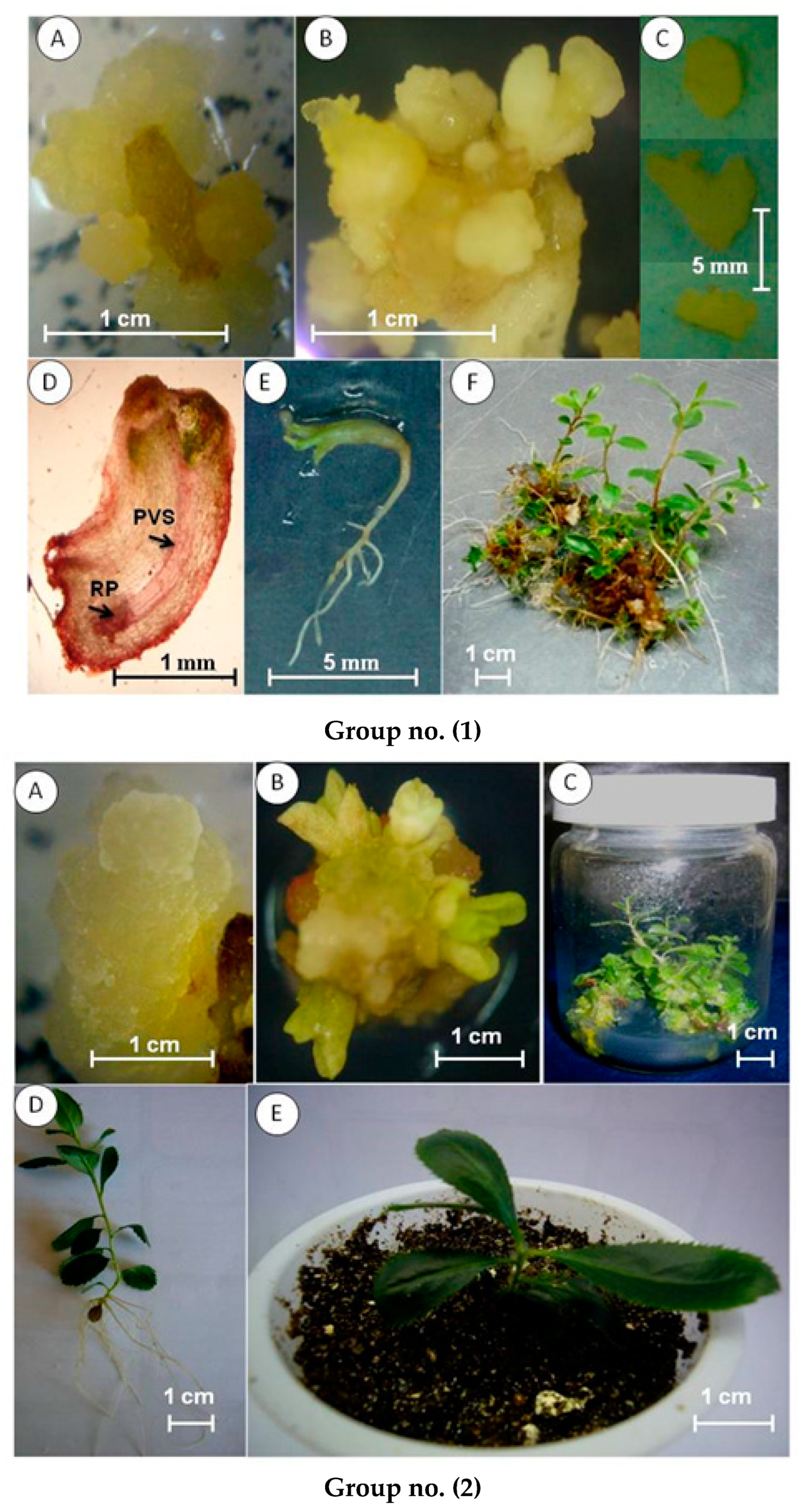
Figure 32. A case study for plants in vitro as a promising tool for plant nutrition. Group (1): Somatic embryogenesis of strawberry tree (Arbutus unedo L.), where photos (A,B) are of embryogenic callus; (C) different stages of embryo (globular, heart, and torpedo); (D) torpedo stage of embryo; (E) cotyledonary stage of embryo; (F) plantlets initiated from somatic embryos. Group (2): Indirect propagation of strawberry tree, where photo (A) is of callus induction; (B) callus differentiation; (C) shoot formed from callus; (D) shoot rooted; (E) acclimatized plants. All photos by El-Mahrouk.
-
By 2030, ending hunger;
-
By 2030, ending all malnutrition forms;
-
By 2030, doubling agricultural productivity;
- By 2030, ending hunger;
- By 2030, ending all malnutrition forms;
- By 2030, doubling agricultural productivity;
- By 2030, ensuring sustainable food production systems [16].
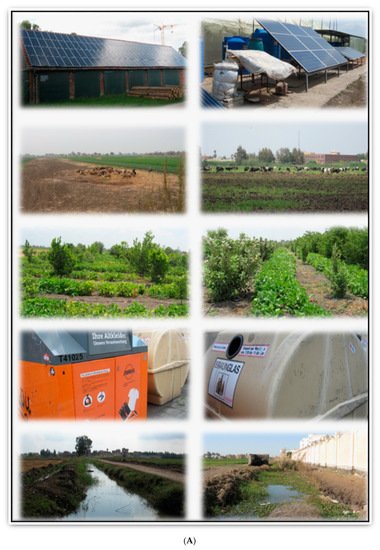

Figure 43. (A) Some creative technologies that boost agricultural output while protecting environmental quality, which may include saving the required energy for different agricultural practices (the upper photos), saving proper and sufficient feeds of farm animals (the 3rd and 4th photos), intercropping using horticultural crops (the 5th and 6th photos), domestic wastes and their sorting/collecting in certain containers (the 7th and 8th photos of horticultural plants), and irrigation canals and drainers and their efficiency (the 9th and 10th photos). All previous agro-practices need to be sustained. All photos by El-Ramady. (B) The production of seedlings in agricultural nurseries is very important, using different materials for growing media to supply the agriculture in field or greenhouse with healthy seedlings. All previous agro-practices need to be sustained. All photos of horticultural seedlings (such as pepper and tomato) by El-Ramady.
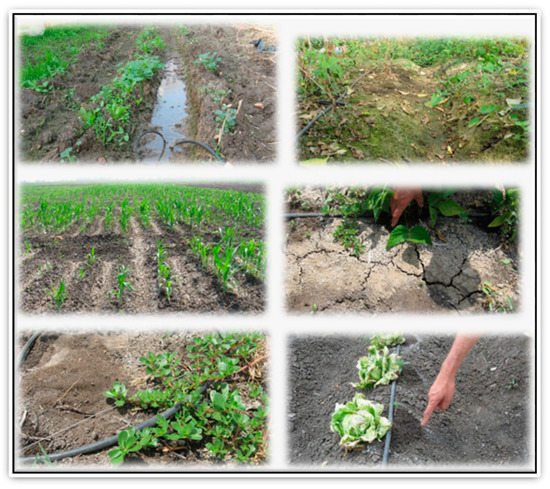
Figure 54. Cultivation in saline/alkaline, waterlogged, and compacted heavy-clay-content soil needs to manage the right crop that can be tolerant against certain obstacles, particularly under arid and semi-arid conditions. These problems include accumulation of salts on the soil surface, growing the salinity-loving grasses, waterlogged soil (the upper photos of grasses), salinity/alkalinity stress (the middle photos of maize), sodium appearance in dispersion of soil particles on the soil surface (lower photos of common purslane and lettuce), etc. All photos by El-Ramady.
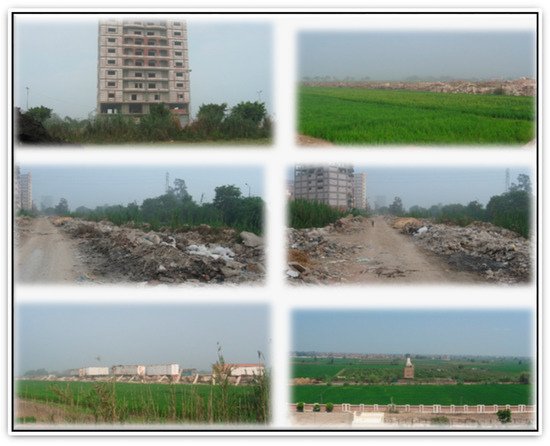
Figure 65. Urban sprawl causes several forms of damage to agricultural soils such as building on these soils, discarding the wastes of building or construction, and collecting and storing several wastes on these soils. These photos of damage can impact agricultural production from arable lands and food security. All photos from different places in Egypt by El-Ramady.
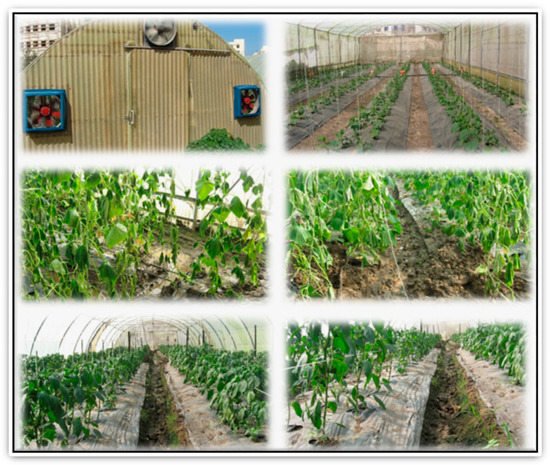
Figure 76. Agricultural production under greenhouse conditions is very important for developed countries, especially during the period of falling snow in winter, as greenhouses are protected houses for crop production, and for developing countries, particularly under arid and semi-arid conditions, which may face a range of troubles with lack of facilities, aeration (the upper left photo), control of the soil moisture content (the middle and lower photos of cucumber and pepper), etc. All photos by El-Ramady.
References
- Stratton, A.E.; Kuhl, L.; Blesh, J. Ecological and Nutritional Functions of Agroecosystems as Indicators of Smallholder Resilience. Front. Sustain. Food Syst. 2020, 4, 543914.
- Goncharova, N.A.; Merzlyakova, N.V. Food Shortages and Hunger as a Global Problem. Food Sci. Technol. 2022, 42, e70621.
- Bang, T.C.; Husted, S.; Laursen, K.H.; Persson, D.P.; Schjoerring, J.K. The Molecular–Physiological Functions of Mineral Macronutrients and Their Consequences for Deficiency Symptoms in Plants. New Phytol. 2021, 229, 2446–2469.
- Roberts, D.P.; Mattoo, A.K. Sustainable Crop Production Systems and Human Nutrition. Front. Sustain. Food Syst. 2019, 3, 72.
- Cakmak, I. Plant Nutrition Research: Priorities to Meet Human Needs for Food in Sustainable Ways. Plant Soil 2002, 247, 3–24.
- Elbasiouny, H.; El-Ramady, H.; Elbehiry, F.; Rajput, V.D.; Minkina, T.; Mandzhieva, S. Plant Nutrition under Climate Change and Soil Carbon Sequestration. Sustainability 2022, 14, 914.
- Moses, T.; Goossens, A. Plants for Human Health: Greening Biotechnology and Synthetic Biology. J. Exp. Bot. 2017, 68, 4009–4011.
- Bruulsema, T.; Cakmak, I.; Dobermann, A.; Gerard, B.; Majumdar, K.; McLaughlin, M.; Reidsma, P.; Vanlauwe, B.; Wollenberg, E.K.; Zhang, F.; et al. Scientific Panel on Responsible Plant Nutrition. A New Paradigm for Plant Nutrition. Issue Brief 01. Available online: https://www.apni.net/downloads/sprpnIss01.pdf (accessed on 4 April 2022).
- Kumar, V.; Srivastava, A.; Suprasanna, P. Plant Nutrition and Food Security in the Era of Climate Change; Academic Press: Oxford, UK; Elsevier: Amsterdam, The Netherlands, 2022.
- Perrino, E.V.; Valerio, F.; Jallali, S.; Trani, A.; Mezzapesa, G.N. Ecological and Biological Properties of Satureja Cuneifolia Ten. and Thymus Spinulosus Ten.: Two Wild Officinal Species of Conservation Concern in Apulia (Italy). A Preliminary Survey. Plants 2021, 10, 1952.
- Valerio, F.; Mezzapesa, G.N.; Ghannouchi, A.; Mondelli, D.; Logrieco, A.F.; Perrino, E.V. Characterization and Antimicrobial Properties of Essential Oils from Four Wild Taxa of Lamiaceae Family Growing in Apulia. Agronomy 2021, 11, 1431.
- Perrino, E.V.; Wagensommer, R.P. Crop Wild Relatives (CWRs) Threatened and Endemic to Italy: Urgent Actions for Protection and Use. Biology 2022, 11, 193.
- Fageria, N.K. Soil Fertility and Plant Nutrition Research under Controlled Conditions: Basic Principles and Methodology. J. Plant Nutr. 2005, 28, 1975–1999.
- Fageria, N.K. Soil Fertility and Plant Nutrition Research under Field Conditions: Basic Principles and Methodology. J. Plant Nutr. 2007, 30, 203–223.
- El-Ramady, H.R.; Alshaal, T.A.; Shehata, S.A.; Domokos-Szabolcsy, É.; Elhawat, N.; Prokisch, J.; Fári, M.; Marton, L. Plant Nutrition: From Liquid Medium to Micro-Farm. In Sustainable Agriculture Reviews 14; Ozier-Lafontaine, H., Lesueur-Jannoyer, M., Eds.; Sustainable Agriculture Reviews; Springer International Publishing: Cham, Switzerland, 2014; Volume 14, pp. 449–508. ISBN 978-3-319-06015-6.
- United Nations Sustainable Development Goals. Sustainable Development Knowledge Platform. Available online: https://sustainabledevelopment.un.org/sdgs (accessed on 20 April 2022).
- Dordas, C. Role of Nutrients in Controlling Plant Diseases in Sustainable Agriculture: A Review. In Sustainable Agriculture; Lichtfouse, E., Navarrete, M., Debaeke, P., Véronique, S., Alberola, C., Eds.; Springer: Dordrecht, The Netherlands, 2009; pp. 443–460. ISBN 978-90-481-2665-1.
- Isaac, W.-A.; Felix, N.; Ganpat, W.G.; Saravanakumar, D.; Churaman, J. Sustainable Climate-Smart Agricultural Solutions to Improve Food and Nutrition Security in Trinidad and Tobago. In Development, Political, and Economic Difficulties in the Caribbean; Bissessar, A.M., Ed.; Springer International Publishing: Cham, Switzerland, 2019; pp. 167–195. ISBN 978-3-030-02993-7.
- Babu, S.; Singh, R.; Yadav, D.; Rathore, S.S.; Raj, R.; Avasthe, R.; Yadav, S.K.; Das, A.; Yadav, V.; Yadav, B.; et al. Nanofertilizers for Agricultural and Environmental Sustainability. Chemosphere 2022, 292, 133451.
- Elemike, E.E.; Uzoh, I.M.; Onwudiwe, D.C.; Babalola, O.O. The Role of Nanotechnology in the Fortification of Plant Nutrients and Improvement of Crop Production. Appl. Sci. 2019, 9, 499.
- Agrawal, S.; Kumar, V.; Kumar, S.; Shahi, S.K. Plant Development and Crop Protection Using Phytonanotechnology: A New Window for Sustainable Agriculture. Chemosphere 2022, 299, 134465.
- Cappelli, S.L.; Domeignoz-Horta, L.A.; Loaiza, V.; Laine, A.-L. Plant Biodiversity Promotes Sustainable Agriculture Directly and via Belowground Effects. Trends Plant Sci. 2022, 27, 674–687.
- Ditta, A.; Arshad, M. Applications and Perspectives of Using Nanomaterials for Sustainable Plant Nutrition. Nanotechnol. Rev. 2016, 5, 209–229.
- Perea Vélez, Y.S.; Carrillo-González, R.; González-Chávez, M. Interaction of Metal Nanoparticles–Plants–Microorganisms in Agriculture and Soil Remediation. J. Nanopart. Res. 2021, 23, 206.
- Bahrulolum, H.; Nooraei, S.; Javanshir, N.; Tarrahimofrad, H.; Mirbagheri, V.S.; Easton, A.J.; Ahmadian, G. Green Synthesis of Metal Nanoparticles Using Microorganisms and Their Application in the Agrifood Sector. J. Nanobiotechnol. 2021, 19, 86.
- Koopaee, H.K.; Rezaei, V.; Esmailizadeh, A. DNA Biosensors Techniques and Their Applications in Food Safety, Environmental Protection and Biomedical Research: A Mini-Review. J. Cell Dev. Biol. 2020, 3, 28–35.
- García-Aljaro, C.; Bangar, M.A.; Baldrich, E.; Muñoz, F.J.; Mulchandani, A. Conducting Polymer Nanowire-Based Chemiresistive Biosensor for the Detection of Bacterial Spores. Biosens. Bioelectron. 2010, 25, 2309–2312.
- Sun, Y.; Fang, L.; Wan, Y.; Gu, Z. Pathogenic Detection and Phenotype Using Magnetic Nanoparticle-Urease Nanosensor. Sens. Actuators B Chem. 2018, 259, 428–432.
- Podar, D.; Maathuis, F.J.M. Primary Nutrient Sensors in Plants. iScience 2022, 25, 104029.
More
